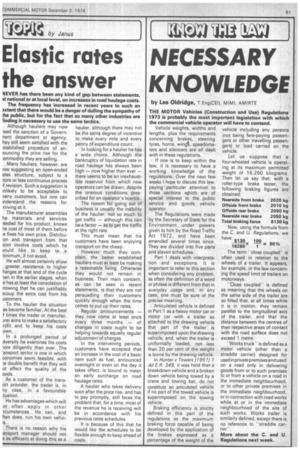NECESSARY KNOWLEDGE
Page 85

If you've noticed an error in this article please click here to report it so we can fix it.
by Les Oldridge, T. Eng (CE I), MIMI, AM I RTE
THE MOTOR Vehicles (Construction and Use) Regulations 1973 is probably the most important legislation with which the commercial vehicle operator will have to contend.
Vehicle weights, widths and lengths, plus the requirements concerning brakes, steering tyres, horns, win, speedometers and silencers are all dealt with in these regulations.
If one is to keep within the law, it is necessary to have a working knowledge of the regulations. Over the next few weeks I hope to discuss this law, paying particular attention to those sections w,hich are of special interest to the public service and goods vehicle operator.
The Regulations were made by the Secretary of State for the Environment under powers given to him by the Road Traffic Act 1972, and have been amended several times since. They are divided into five parts and eleven schedules.
Part 1 deals with interpretation and exceptions. It is important to refer to this section when considering any problem, as often the definition of a word or phrase is different from that in everyday usage and, in any case, one must be sure of the precise meaning.
Articulated vehicle is defined in Part 1 as a heavy motor car or motor car with a trailer so attached to the drawing vehicle that part of the trailer is superimposed upon the drawing vehicle, and, when the trailer is uniformally loaded, not less than 20 per cent of the weight is borne by the drawing vehicle.
In Hunter v Towers (1951) 1 All E.R. 349, it was held that a breakdown vehicle and a broken down vehicle being towed by a crane and towing bar, do not constitute an articulated vehicle if no part of the towed vehicle is superimposed on the towing vehicle.
Braking efficiency is strictly defined in this part of the regulations as the maximum braking force capable of being developed by the application of the brakes expressed as a percentage of the weight of the vehicle including any persons (not being fare-paying passengers or other travelling passengers) or load carried on the vehicle.
Let us suppose that a four-wheeled vehicle is operating at its maximum permitted weight of 16,250 kilograms. Then let us say that, with a roller-type brake tester, the following braking figures are obtained: Nearside front brake 2020 kg Offside front brake 2010 kg Offside rear brake 2050 kg Nearside rear brake 2050 kg Total braking force 8130 kg Now, using the formula from the C. and U. Regulations, we
have: 8130x100
= 50% 16260 1
The term "close coupledis often used in relation to the wheels of a trailer. It appears, for example, in the law concerning the speed limit of trailers on motorways.
"Close coupled" is defined as meaning that the wheels on the same side of the trailer are so fitted that, at all times while it is in motion, they remain parellel to the longitudinal axis of the trailer, and that the distance between the centres of, their respective areas of contact with the road surface does not exceed 1 metre.
"Works truck"' is defined as a motor vehicle (other than a straddle carrier) designed for used in private prem ises and used on a road only in delivering goods from or to such premises to or from a vehicle on a road in the immediate neighbourhood, or to other private premises in the immediate neighbourhood, or in connection with road works while at or in the immediate neighbourhood of the site of such works. Works trailer is similarly defined, except there is no reference to "straddle carrier''.
More about the C. and U. Regulations next week.






























































































































